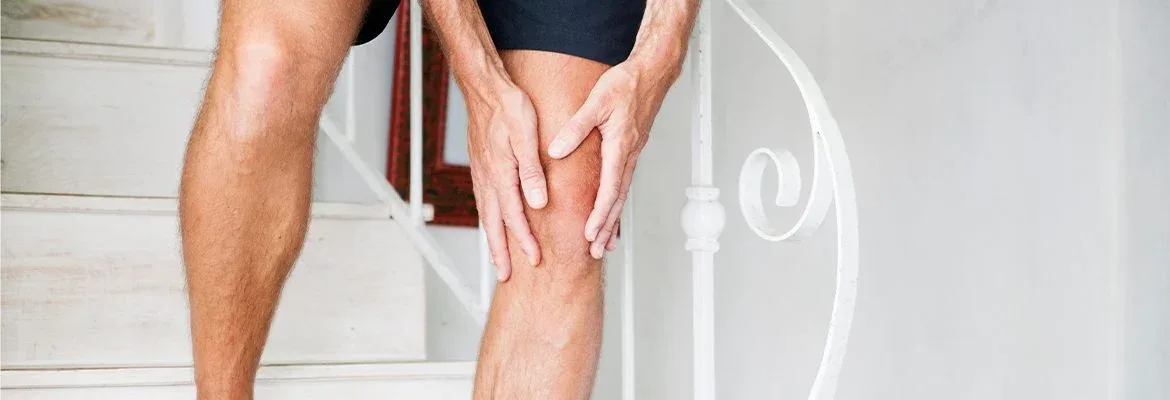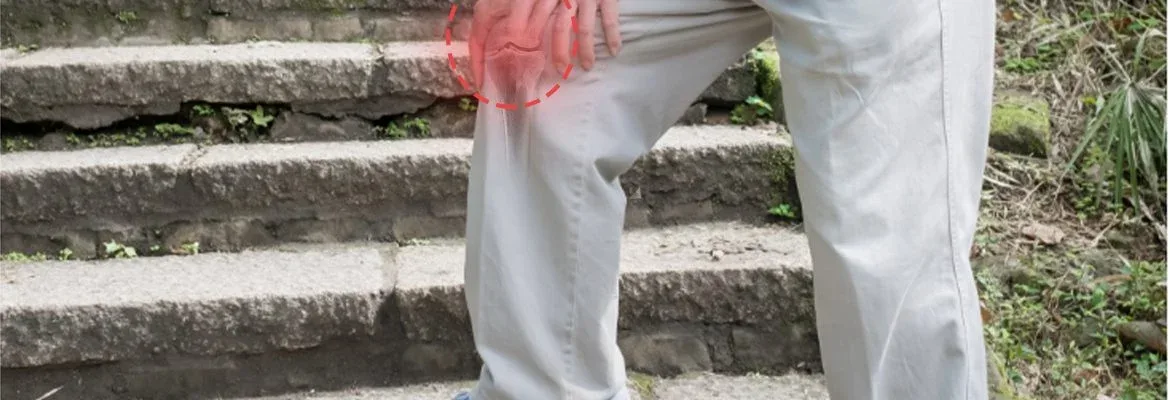When you take the stairs, do you feel pain in one leg your knees? You’re not alone. Many people suffer severe knee pain when descending stairs, which can be frustrating and debilitating.
Knee pain is a complaint affecting people of all ages and lifestyles. However, it can be particularly problematic when it comes to stairs, making everyday tasks like going to work or doing household chores difficult and painful.
This article will analyze the factors behind knee pain going down stairs and provide guidance on alleviating the discomfort and returning to regular routines.
· Why does your knee pain going down stairs?
When you descend the stairs, your whole knee cap and joint experiences more force and pressure than walking on a flat surface. This increased pressure can cause the cushioning cartilage in your knee cap and joint to wear down over time, leading to pain and discomfort. Additionally, if you have knee injuries or conditions, such as arthritis or a torn ligament, the added stress of descending the stairs can exacerbate the pain.
· Why does your knee hurt when you go upstairs?
When you climb stairs, your knee joint is repeatedly flexed and extended, causing increased pressure and stress on the joint. This can aggravate existing injuries or conditions, such as arthritis or tendonitis, leading to pain and discomfort. Additionally, the muscles and tendons around the knee joint may become strained or overworked, contributing to knee pain while climbing stairs.
I. How to Beat Knee Pain on Stairs

knee pain going down stairs
· 1. Strengthen your leg muscles:
Building strength in your leg muscles can help support your knees and reduce pain. Exercises like squats, lunges, and leg presses can help strengthen the muscles around your knees.
· 2. Wear supportive shoes:
When ascending stairs, wearing shoes with sufficient arch support and cushioning might lessen the impact on your knees.
· 3. Use proper form:
Keep your knees aligned with your ankles when climbing stairs, and avoid leaning forward. Use the handrail for support if needed.
· 4. Take breaks:
If you experience knee pain while climbing stairs, take frequent breaks to rest your knees and avoid overexerting yourself.
· 5. Try low-impact exercise:
Activities like swimming, cycling, and yoga can help improve patella strength and flexibility without putting pressure on your joints.
· 6. Consider physical therapy:
To strengthen the patella and alleviate pain, a physical therapist can design a program specifically for you.
· 7. Consult with a doctor:
If your knee pain is severe, go and consult a doctor to rule out any underlying terms and discuss possible treatment options.
II. Causes of Knee Pain While Using Stairs

knee pain going down stairs
Many people may experience knee pain frequently, especially while ascending stairs. Daily tasks may become more challenging, and this pain may restrict movement. The reasons for experiencing knee pain when climbing and descending stairs will be covered in this part, along with solutions for prevention.
· Knee Osteoarthritis
Knee pain while using stairs is often caused by osteoarthritis, which results from the wearing down of cartilage in the knee joint, causing bone rubbing and resulting in pain and stiffness, particularly when ascending stairs. One typical cause of knee pain when descending stairs is osteoarthritis of the knee.
· Patellofemoral Pain Syndrome
Another typical reason for knee pain when climbing stairs is patellofemoral pain syndrome. Pain and suffering result from this ailment when the patella (kneecap) does not move smoothly over the femur (thigh bone). Overuse, muscular imbalances, or an absent patella can be common causes of knee pain that bring this on. Patellofemoral Pain Syndrome (PFPS) is a common knee state that can cause pain when climbing stairs or kneeling.
· Meniscus Tears
Meniscus tears, which affect the knee’s shock-absorbing cartilage, can cause knee pain and swelling, especially while climbing or descending stairs.
· Runner’s Knee
Runner’s patella is a common term for knee pain that occurs in runners but can also affect non-runners. This painful condition is caused by cartilage irritation on the tendon of the patella’s underside, leading to pain and discomfort when climbing stairs.
· IT Band Syndrome
The iliotibial band, an influential band of tissue that rises from the hip to the knee, can become tight and inflamed, resulting less pain, in IT band syndrome. When climbing stairs, this may result in patella soreness on the outside.
III. Diagnosis

knee pain going down stairs
Knee pain diagnosis can be complicated and requires several tests for accurate determination. A blood test will reveal any hints of infection, which can cause discomfort and swelling in the knee joint. An X-ray would help show any fractures or abnormalities, such as bone spurs or cartilage damage, that could be causing the discomfort. Additionally, an MRI can provide a more detailed look at soft tissues, such as ligaments, tendons, and muscles, to determine if they cause the knee symptoms themselves. Finally, the healthcare provider may physically touch the affected area to locate any tenderness or mild swelling indicative of inflammation or other issues in the joint structure.
By gathering information from these various tests, a diagnosis can be made regarding an individual’s knee pain. The same healthcare professional or provider can then decide what treatment is best to alleviate their symptoms and get them back to leading healthy, active lifestyles. The following terms are useful in case to diagnose anterior knee pain;
· Arthritis
Arthritis is a state that affects the joints in the body. The common forms of arthritis that affect the patella are osteoarthritis and rheumatoid arthritis. People with arthritis often experience pain, stiffness, and swelling in the knee joint. The pain can worsen when walking up or down stairs or standing for extended or long periods together.
· Bursitis
Bursitis is an inflammation of the bursae, which are fluid-filled sacs in shin bone and tendon that act as a cushion for the body’s joints. When the bursae become irritated or inflamed, bursitis may develop. People with bursitis often experience pain, swelling, and tenderness in the knee joint. The pain can be worse when walking up or down stairs or kneeling.
IV. Treatment

Treatment
We will discuss some treatments and exercises that can help relieve knee pain while on flat feet and going downstairs.
· Rest and Ice
If you experience knee pain while going downstairs, it’s important to rest and apply ice to the knee hurts the affected area. Resting your knee for a few days can help reduce the swelling and inflammation that may be causing the pain. Using ice packs on the joints for 15-20 minutes several times daily can also help reduce pain and swelling.
· Exercise and Stretching
Regular exercises can help strengthen the quadriceps muscle and knee muscles, reducing pain and improving mobility. Exercises like squats, lunges, and leg extensions can help support the quadriceps muscles, while hamstring stretches can help reduce swelling and improve flexibility.
· Use of Braces
Braces can assist in the pain going providing support and stability to the knee joint. Different knee braces include compression sleeves, hinged braces, and patellar stabilizers. The type of knee brace you need will depend on the intensity of your knee pain and the underlying cause your knee hurts.
· Physical Therapy
If your knee pain is severe, it’s important to get aid of a physical therapist. A physical therapist can evaluate your patella and develop a personalized treatment plan, including exercises, stretches, and other modalities to help decrease discomfort and improve mobility.
· Medications
Ibuprofen and acetaminophen, two over-the-counter painkillers, can help lessen knee discomfort and inflammation. However, it’s important to use these medications as directed and to avoid taking them for an extended period.
· Surgery
Surgery may be crucial to treat knee pain caused by a structural problem like a torn ligament or cartilage. If conservative treatments like rest, exercise, and physical therapy are ineffective, your doctor may recommend surgery as a last resort.
V. Recommended Exercises

Recommended-Exercises
Knee pain can significantly impact one’s ability to walk downstairs and may be caused by various factors, including injury, arthritis, or overuse. There are recommended exercises everyday activities you can do to strengthen your knees and make walking down stairs easier. Here are three activities to try:
· Step-Ups
Step-ups are for strengthening the muscles around your knees. To do this exercise:
- Find a step or bench about knee height.
- Move up with your right foot, then bring your left foot up to meet it.
- Step back down with your right foot, then your left.
- Repeat for 10-15 reps, then switch to your other leg. As you get stronger, you can add weights or increase the height of the step to make the exercise more challenging.
· Squats
Squats are a classic lower-body exercise that can help strengthen your knees. To do a squat:
- Stand with your feet shoulder-width apart.
- Lower yourself as if sitting on a stool, keeping your weight in your heels.
- Make sure your knees don’t go past your toes.
- Push back up through your back heels to return to standing.
- Repeat for 10-15 reps.
· Lunges
Lunges are another great exercise for strengthening your knees. Move forward with your right foot and lower your body until your right thigh is aligned with your outer heel on the ground to make a lunge. Make sure your knee doesn’t go past your toes. Push back up through your right heel to return to standing, then repeat with your left leg. Do 10-15 reps on each leg.
VI. FAQS
- Why do I have trouble walking and going down stairs and steps?
There could be many causes why someone may have trouble walking downstairs. One possible reason could be a problem with balance or coordination, which a neurological disorder or injury could cause. Another possible reason could be joint pain or stiffness, causing pain, particularly in the knees or hips, making it difficult to navigate stairs.
- How can I make my knees stronger?
There are several ways to make your knees stronger. Exercise regularly, maintain a healthy body weight throughout, wear proper footwear, stretch before and after exercise, and use good form when exercising.
- Why does my leg hurt when I go into knee pain going down stairs on the stairs?
When you go down the stairs, your knee and leg must support your body weight and absorb the impact of each step. This places pressure on your lower leg joints, tendons, and muscles, leading to pain.
- Can walking relieve knee pain?
Yes, walking can be good for knee pain because it helps to strengthen the muscles around the knee joint and improve overall joint mobility. Walking also helps to promote blood flow and decrease inflammation, which can help to alleviate pain and stiffness in the knee.
